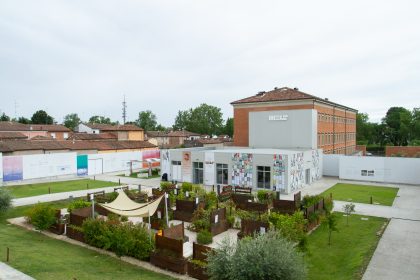MEIS was a challenge from the moment it was built: to transform a place of confinement into an open and inclusive space. Meet Rachel Silvera, Director of Communications at MEIS, who tells us about this important place in Italian Jewish cultural heritage and the many projects it organizes.

Jguideeurope : Can you present us some of the objects shown at the permanent exhibition dedicated to Jewish Italian history?
Rachel Silvera : In our permanent exhibition “Jews, an Italian Story” we display objects loaned by other Italian museums, reconstructions, and multimedia installations. For example, our visitors can admire the relief from the Arch of Titus showing the spoils of the Temple, a plaster reproduction made in 1930. The relief depicts the triumphal procession of Titus in Rome after the military campaign in Judaea, parading the spoils looted from the Temple of Jerusalem. You can also find the reconstructions of Jewish Catacombs, in Rome (like Villa Torlonia and Vigna Randanini) and in the South of Italy (Venosa).
How do you perceive the evolution of interest in Shoah studies in Italy?
It is a fundamental way: 1) to know the history and strengthen awareness 2) to offer useful tools to the students and transmit values to the next generation 3) to fight Holocaust denial and distortion.
Which educational projects focusing on the Shoah are being conducted by the Museum? During the pandemic we have organized two important online events for school students devoted to the Shoah and the future of the remembrance. We have reached more than 12.000 students. Every year we also offer an online course addressed to teachers focused on Shoah history and the relationship with new medias. We are working also on a project financed by the Ministry of Public Education along with a high school from Ferrara (Liceo Roiti) and the Institut of Contemporary History of Ferrara: the students are working with us to create an exhibition focused on the Racial Laws and the persecution.

Can you tell us about a moving encounter at the Museum with either a visitor or exhibition participants?
The Museo Nazionale dell’Ebraismo Italiano e della Shoah (National Museum of Italian Judaism and the Shoah) is in Ferrara, in the former prisons of via Piangipane. During the war, its walls imprisoned antifascist opponents and Jews, including the writer Giorgio Bassani, Matilde Bassani and Corrado Israel De Benedetti. The challenge was to transform a place of confinement into an open, inclusive space.
During the last International Holocaust Remembrance Day, we unveiled a commemorative plaque that remember the story of this place. The special guest was Patrizio Bianchi, the Italian Minister of Education. It was a really touching moment.
What will the next temporary exhibition be about?
The exhibition will dwell on the many meanings of the Feast of Sukkot. The opening will be on October 14. The idea is to present to the public an insight into the religious precepts, the ways the festivity is celebrated, its’ connection with nature and the many expressions it generates. The exhibition will be carried on by MEIS Director Amedeo Spagnoletto, Curator Sharon Reichel, and Architect Giulia Gallerani.
The exhibition narrative starts from the assessment of the Festival of Sukkot, with the description of the seven days of the festival, an introduction that will give the visitors the basic notions to understand the rest of the exhibition, since from then on, they will be encouraged to engage directly, discovering content through interaction. We will also display the 10 panels of the “Sukkah of Praglia”, painted wooden panels from a sukkah, produced in the Venetian area probably in the late eighteenth or nineteenth century, owned by the Abbazia di Praglia in Teolo (Padua).
The Praglia sukkah includes ten panels, painted with biblical subjects and accompanied by Hebrew writings. Some panels evoke the Jewish holidays Pesach and the construction of the sukkah (Sukkot). Others illustrate several important biblical personages, such as Abraham, Melchizedek, Isaac and Rebecca, Jacob, Rachel, Joshua, King David, Moses, and Elijah.